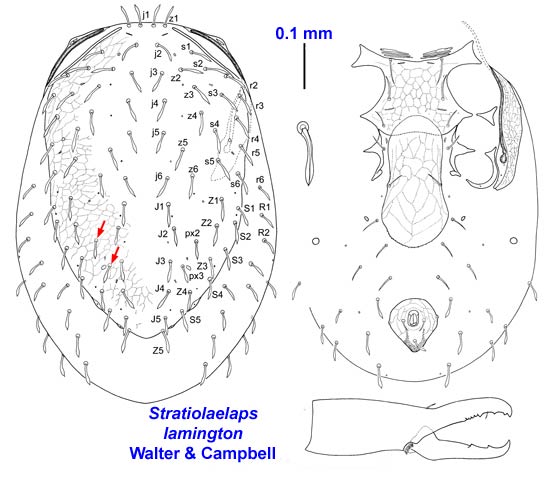Taxonomic Position
Cohort Gamasina
Subcohort Dermanyssiae
Superfamily Dermanyssoidea
Laelapidae Trägårdh s.l.
Subfamily Hypoaspidinae Vitzthum
Tribe Pseudoparasitini
Vitzthum
Stratiolaelaps lamington Walter & Campbell
Diagnostic characters. Lamington-group species (posterior margin of sternal shield concave, gnathotectum with median and lateral processes) with serrate fixed cheliceral digit, genital setae (st5) inserted on margin of genital shield, 1-2 pairs of accessory setae (px2-3), and normal setation in the marginal-submarginal region.

Similar taxa.
Key to Adult females of Species of Stratiolaelaps (from Walter & Campbell 2002)
1. Fixed digit of chelicera with 2 teeth anterior to pilus dentilis, followed by serrate region; margin of gnathotectum denticulate, with longer median and lateral processes; posterior margin of sternal shield concave - lamington group (2)
- Fixed digit of chelicera with 2 teeth to either side of pilus dentilis; margin of gnathotectum denticulate, with single, smooth median process; posterior margin of sternal shield irregularly convex or produced medially - miles group (3)
2. Dorsal shield with 39 pairs of spatulate-mucronate setae, paired accessory setae px2, px3 present; postanal seta and marginal setae r6 and R1 spatulate - S. lamington
- Dorsal shield with 37 pairs of spatulate-acuminate setae, paired accessory px setae absent; postanal seta and marginal setae r6 and R1 acicular - S. womersleyi
3. Most dorsal shield setae relatively short, tips not exceeding next seta in series; setae J4 and J5 subequal, Z5 20-40% longer - 4
- Most dorsal shield setae relatively long (e.g. all podonotal setae except z1 are 51-65 µm), tips approaching or passing insertion of next seta in series; setae J4 and Z5 much longer than J5 (50-60% and 60-100% longer, respectively) - S. marilyn
4. Setae r6 similar toothers; dorsal setae of femora and genua of legs II and IV mostly spatulate; dorsal shield 585-690 µm long; fixed digit of male chelicera with one tooth posterior to pilus dentilis - 5
- Setae r6 simple; dorsal setae of femora and genua of legs II and IV simple; dorsal shield 540-590 µm long; fixed digit of male chelicera with 3-5 teeth posterior to pilus dentilis - S. lorna
5. Dorsal shield tapering gradually after level of setae S2; postanal seta short, only about 60% length of paranal setae; palp apotele with 2 subequal tines - S. miles sensu Evans and Till 1966
- Dorsal shield tapering sharply after level of setae S2; middle article of chelicera >260 µm long; postanal and paranal setae subequal in length; palp apotele with 2 subequal tines and a small basal tine - S. scimitus (Womersley)
Ecology & Distribution. Species of Stratiolaelaps are predatory and some are used in greenhouses against thrips and fungus gnats; S. lamington is an arboreal mite that inhabits suspended litter in rainforests in eastern Australia.
References
Aswegen, P. I. M. and Loots, G. C. 1970. A taxonomic study of the genus Hypoaspis Canestrini sens. lat. (Acari: Laelapinae) in the Ethiopian region. Publ. cult. Co. Diam. Ang., Lisboa 82: 167-214
Berlese, A. 1892. Acari, Myriopoda et Scorpiones hucusque in Italia reperta 63, 17 text pages + Plates 1-10. (Reprint by Junk, The Hague, 1979).
Berlese, A. 1916. Centuria seconda di Acari nuovi. Redia 12, 125-177.
Chambers, R .J., Wright, E. M., and Lind, R. J. 1993. Biological control of glasshouse sciarid flies (Bradysia spp.) with the predatory mite, Hypoaspis miles, on cyclamen and poinsettia. Biocontrol Sci. Tech. 3, 285-293.
Evans, G. O., and Till, W. M. 1966. Studies on the British Dermanyssidae (Acari: Mesostigmata). Part II. Classification. Bull. Br. Mus. Nat. Hist. (Zool.) 14, 107-370.
Tenorio, J. M. 1982. Hypoaspidinae (Acari: Gamasida: Laelapidae) of the Hawaiian Islands. Pac. Insects 24, 259-274.
Wright, E.M., and Chambers, R.J.. 1994. The biology of the predatory mite Hypoaspis miles (Acari: Laelapidae), a potential biological control agent of Bradysia paupera (Dipt.: Sciardiae). Entomophaga 39, 225-235.
Womersley, H. 1956. On some new Acarina-Mesostigmata from Australia, New Zealand and New Guinea. J. Linn. Soc. (Zool.) 42, 505-599.
Zumpt, F., and Patterson, P. M. 1951. Further notes on laelaptid mites parasitic on vertebrates. A preliminary study to the Ethiopian fauna. J. Entomol. Soc. Sth Afr. 14, 63-93.
Gilyarov MS & Bregatova NG (eds) 1977.
Handbook for the Identification of Soil-inhabiting Mites, Mesostigmata. Zoological Institute of the Academy of
Sciences: Petrograd [In Russian]
Karg W.
1993. Acari (Acarina), Milben
Parasitiformes (Anactinochaeta) Cohors Gamasina Leach, Raubmilben. Die Tierwelt Deutschlands 59:
1-523. [In German]
Walter DE, Campbell
NJH. 2003. Exotic vs endemic biocontrol agents: Would the real
Stratiolaelaps miles (Berlese) (Acari: Mesostigmata: Laelapidae) please
stand up? Biological Control 26: 253-269.